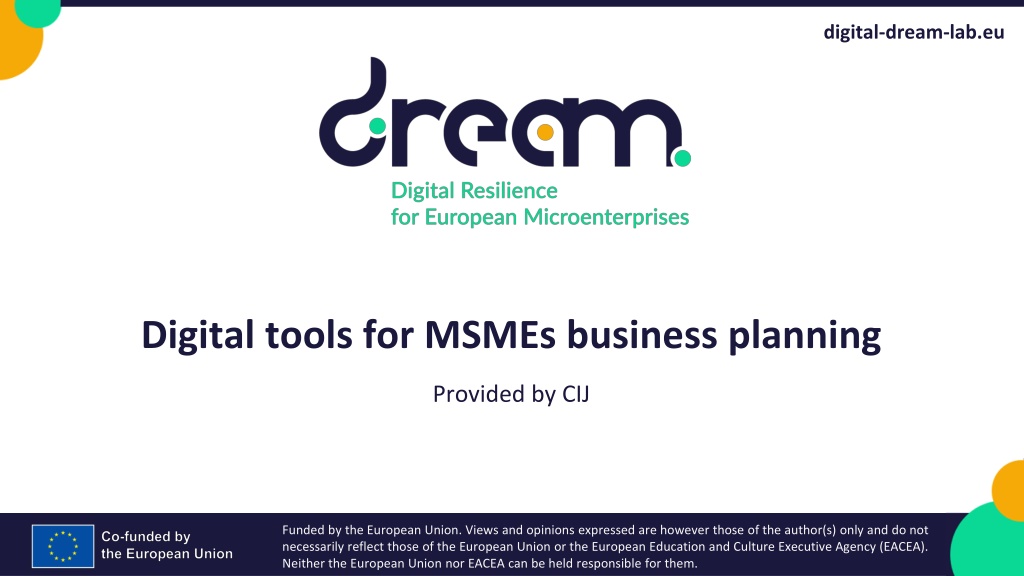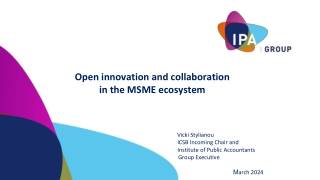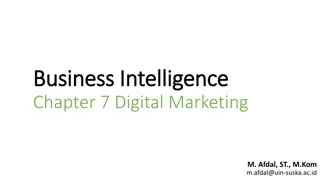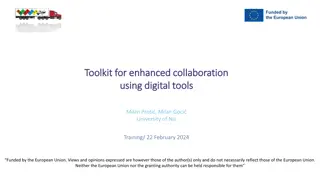Digital Business Planning for MSMEs: Tools and Strategies
Exploring the process of digital business planning can help MSMEs assess risks, identify opportunities, and enhance their operations. This module covers key concepts, data-driven approaches, and the use of digital tools for effective business planning, supported by funding from the European Union. By understanding these principles, businesses can innovate and improve their processes to drive success.
Download Presentation

Please find below an Image/Link to download the presentation.
The content on the website is provided AS IS for your information and personal use only. It may not be sold, licensed, or shared on other websites without obtaining consent from the author. Download presentation by click this link. If you encounter any issues during the download, it is possible that the publisher has removed the file from their server.
E N D
Presentation Transcript
digital-dream-lab.eu Digital tools for MSMEs business planning Provided by CIJ Funded by the European Union. Views and opinions expressed are however those of the author(s) only and do not necessarily reflect those of the European Union or the European Education and Culture Executive Agency (EACEA). Neither the European Union nor EACEA can be held responsible for them.
Index Unit 1. Introduction to digital business planning Section 1.1. What is business planning, and how can it be digital ? Section 1.2 Digital tools for business planning by the function Unit 2. How can I run a data driven business and which is the impact ? Section 2.1 Definition of Data driven and its meaning in the context of business planning Section 2.2 Choosing indicators to monitor data driven activities Unit 3. Digital Tools for business planning Section 3.1. Digital tools for management Section 3.2. Digital tools to communicate and collaborate Section 3.3 Digital tools to brainstorm, creative thinking & innovate Funded by the European Union. Views and opinions expressed are however those of the author(s) only and do not necessarily reflect those of the European Union or the European Education and Culture Executive Agency (EACEA). Neither the European Union nor EACEA can be held responsible for them.
Learning objectives At the end of this module, you will be able to: To comprehend the key concepts and principles of digital business planning To have knowledge about data driven approach and its advantages To be able to decide when and which digital tools to communicate, collaborate and be creative Funded by the European Union. Views and opinions expressed are however those of the author(s) only and do not necessarily reflect those of the European Union or the European Education and Culture Executive Agency (EACEA). Neither the European Union nor EACEA can be held responsible for them.
Business planning is a process to explore and understand how the business will run: establishing internal processes possible risks identifying opportunities setting indicators to assess its success rate 1. Introduction to digital business planning This process results in a Business Plan which is document in which a business opportunity, or a business already under way, is identified, described and analysed, examining its technical, economic and financial feasibility. The Plan develops all of the procedures and strategies necessary in order to convert the business opportunity into an actual business project. 1.1 What is business planning, and how can it be digital ? It is crucial for MMSE to go through the process Funded by the European Union. Views and opinions expressed are however those of the author(s) only and do not necessarily reflect those of the European Union or the European Education and Culture Executive Agency (EACEA). Neither the European Union nor EACEA can be held responsible for them. of creating a business plan to understand how to innovate and improve their processes.
It is crucial for MMSE to go through the process of creating a business plan to understand how to innovate and improve their processes. 1. Introduction to digital business planning 1.1 What is business planning, and how can it be digital ? A digital Business plan addresses the creation of workflow, objectives and practices for the enterprise to expand its business operations in the digital dimension. For instance selling products or services in an online shop or using digital tools to deal with internal processes such as ordering supplies or inventory. Funded by the European Union. Views and opinions expressed are however those of the author(s) only and do not necessarily reflect those of the European Union or the European Education and Culture Executive Agency (EACEA). Neither the European Union nor EACEA can be held responsible for them.
Here are the best practices to be implemented while creating a business plan: Customer Relationship Management Set Clear Goals and Objectives 1. Introduction to digital business planning Market Research Marketing Strategy SWOT Analysis Operations Plan 1.1 What is business planning, and how can it be digital ? Financial Planning Legal and Regulatory Compliance Budgeting Human Resources Planning Risk Management Technology Integration Sustainability and Social Responsibility Monitoring and Evaluation Adaptability Seek Professional Advice Networking Funded by the European Union. Views and opinions expressed are however those of the author(s) only and do not necessarily reflect those of the European Union or the European Education and Culture Executive Agency (EACEA). Neither the European Union nor EACEA can be held responsible for them.
There are many digital tools which can be used in the process of making a Business plan as well as running management related tasks. There are a variety of tasks which can be facilitated by softwares, here they will be organised by category : 1. Introduction to digital business planning 1.2 Digital tools for business planning by the function Strategic Planning SWOT Analysis Tools, Strategy Mapping Software Financial Planning Financial Forecasting Software, Accounting Software Marketing and Sales Planning Marketing Analytics Tools, CRM Software Project Planning Project management softwares, Gantt Chart Softwares Product development Innovaiton Product Management Software, Idea Management Tools Funded by the European Union. Views and opinions expressed are however those of the author(s) only and do not necessarily reflect those of the European Union or the European Education and Culture Executive Agency (EACEA). Neither the European Union nor EACEA can be held responsible for them.
Risk Management Risk Assessment Software, Compliance softwares 1. Introduction to digital business planning Human Resources Planning Workforce Analytic, HR management Supply Chain and Operations Planning Supply Chain Management Software, Inventory Management Software 1.2 Digital tools for business planning by the function Market Research and Competitive Analysis Survey and Market Research Tools, Competitive Analysis Software Business Continuity and Disaster Recovery Planning Business Continuity Software, Emergency Notification Systems Funded by the European Union. Views and opinions expressed are however those of the author(s) only and do not necessarily reflect those of the European Union or the European Education and Culture Executive Agency (EACEA). Neither the European Union nor EACEA can be held responsible for them.
In the context of business, "data-driven" refers to an approach or decision-making process that relies heavily on data and factual information to guide and support business strategies, operations, and decision-making. This means that organisations prioritise the collection, analysis, and interpretation of data to inform their choices and actions rather than relying solely on intuition or past practices. 2. How can I run a data driven business and which is the impact ? 2.1 Definition of Data driven and its meaning in the context of business planning Funded by the European Union. Views and opinions expressed are however those of the author(s) only and do not necessarily reflect those of the European Union or the European Education and Culture Executive Agency (EACEA). Neither the European Union nor EACEA can be held responsible for them.
Here are the data driven approach key aspects : Data Collection: Gathering relevant and accurate data from various sources, such as customer feedback, market research, sales figures, website analytics, and more. 2. How can I run a data driven business and which is the impact ? Data Analysis: Employing data analytics tools and techniques to process and extract meaningful insights from the collected data. This can involve identifying patterns, trends, correlations, and anomalies within the data. 2.1 Definition of Data driven and its meaning in the context of business planning Informed Decision-Making: Using the insights gained from data analysis to make informed and evidence- based decisions. This may include strategic decisions related to product development, marketing, pricing, and resource allocation. Funded by the European Union. Views and opinions expressed are however those of the author(s) only and do not necessarily reflect those of the European Union or the European Education and Culture Executive Agency (EACEA). Neither the European Union nor EACEA can be held responsible for them.
Continuous Improvement: Continuously monitoring and evaluating business processes and outcomes using data, with the aim of optimizing performance, reducing inefficiencies, and identifying opportunities for growth. 2. How can I run a data driven business and which is the impact ? Personalization: Leveraging customer data to create personalized experiences and offerings, such as targeted marketing campaigns or customized product recommendations. 2.1 Definition of Data driven and its meaning in the context of business planning Risk Mitigation: Assessing and managing business risks by analyzing data to identify potential threats and vulnerabilities. Performance Metrics: Establishing key performance indicators (KPIs) and using data to track progress, measure success, and set benchmarks for improvement. Adaptability: Being agile and responsive to changing market conditions and customer preferences based on data insights, enabling quick adjustments to business strategies. Funded by the European Union. Views and opinions expressed are however those of the author(s) only and do not necessarily reflect those of the European Union or the European Education and Culture Executive Agency (EACEA). Neither the European Union nor EACEA can be held responsible for them.
Selecting the right indicators to monitor in a data-driven business is crucial for effectively measuring performance and making informed decisions. 2. How can I run a data driven business and which is the impact ? 2.2 Choosing indicators to monitor data driven activities The specific indicators you choose will depend on your business's goals, industry, and the data you have available. Here are 10 steps to help you select appropriate indicators: Funded by the European Union. Views and opinions expressed are however those of the author(s) only and do not necessarily reflect those of the European Union or the European Education and Culture Executive Agency (EACEA). Neither the European Union nor EACEA can be held responsible for them.
1. Define Your Business Goals 2. Understand Your Key Performance Areas 3. Identify Key Performance Indicators (KPIs) 4. Prioritize KPIs 5. Ensure Data Availability 6. Set Targets 7. Monitor Regularly 8. Use Data to Drive Decision-Making 9. Adapt as Needed 10.Communicate and Align 2. How can I run a data driven business and which is the impact ? 2.2 Choosing indicators to monitor data driven activities Funded by the European Union. Views and opinions expressed are however those of the author(s) only and do not necessarily reflect those of the European Union or the European Education and Culture Executive Agency (EACEA). Neither the European Union nor EACEA can be held responsible for them.
Digital tools for management have become indispensable for streamlining processes, improving efficiency, and making data-driven decisions in various aspects of business and project management. Here are some digital tools and software solutions commonly used in management: 3. Digital Tools for business planning Project Management Trello, Asana 3.1. Digital tools for management Task and To-Do List Apps Todoist, MIcrosoft To do Collaboration and Communication Tools Slack, Microsoft Teams Customer Relationship Management (CRM) Salesforce, Hubspot Analytics and Data Visualization Tools Tableau, Google Analytic Project Planning and Gantt Chart Tools Microsoft Project, Smartsheets Financial and Accounting Software Quickbox, Xero Funded by the European Union. Views and opinions expressed are however those of the author(s) only and do not necessarily reflect those of the European Union or the European Education and Culture Executive Agency (EACEA). Neither the European Union nor EACEA can be held responsible for them.
HR and Employee Management Tools BambooHR, Workday 3. Digital Tools for business planning Inventory and Supply Chain Management Zoho inventory, SAP ERP File and Document Management Google drive, Dropbox business 3.1. Digital tools for management Time Tracking and Productivity Tools Toggl, RescueTime Marketing Automation Software HubSpot Marketing Hub, Mailchimp Funded by the European Union. Views and opinions expressed are however those of the author(s) only and do not necessarily reflect those of the European Union or the European Education and Culture Executive Agency (EACEA). Neither the European Union nor EACEA can be held responsible for them.
Effective communication and collaboration are essential for businesses and teams to work efficiently, especially in today's digital age. Here are some : 1. Slack: A messaging platform for real-time team communication. It supports channels, direct messages, file sharing, and integrations with various other tools and services. 2. Microsoft Teams: Part of the Microsoft 365 suite, Teams offers chat, video conferencing, file sharing, and integration with Microsoft Office apps. 3. Digital Tools for business planning 3. Zoom: A widely used video conferencing tool for hosting meetings, webinars, and virtual events. It also includes chat and screen-sharing features. 4. Google Workspace (formerly G Suite): Google's suite of collaboration and productivity tools, including Gmail, Google Drive, Google Docs, Google Sheets, and Google Meet. 3.2. Digital tools to communicate and collaborate 5. Asana: A project and task management tool that also includes features for team collaboration and communication, helping teams stay organized. 6. Trello: A visual project management tool that uses boards, lists, and cards to help teams manage tasks and projects collaboratively. 7. Notion: A versatile workspace tool that combines note-taking, project management, and collaboration features. It allows teams to create wikis, databases, and more. 8. Basecamp: A project management and team collaboration tool with features like to- do lists, file sharing, message boards, and scheduling. Funded by the European Union. Views and opinions expressed are however those of the author(s) only and do not necessarily reflect those of the European Union or the European Education and Culture Executive Agency (EACEA). Neither the European Union nor EACEA can be held responsible for them.
9. Miro: An online collaborative whiteboard platform for brainstorming, visualising ideas, and working on diagrams and charts. 10. Jira: A project management and issue tracking tool designed for software development teams. It helps manage tasks, track issues, and collaborate on projects. 11. Monday.com: A work operating system that offers features for project and workflow management, task tracking, and team collaboration. 12. Dropbox: A cloud-based file storage and sharing platform that enables teams to collaborate on documents and share files securely. 3. Digital Tools for business planning 13. Confluence: A collaboration tool from Atlassian, it's designed for creating, sharing, and collaborating on documentation, project plans, and knowledge bases. 3.2. Digital tools to communicate and collaborate 14. Yammer: A corporate social network that allows employees to communicate, collaborate, and share information within an organization. 15. Mattermost: An open-source team messaging platform that offers secure, self-hosted messaging for teams and organizations. 16. Discord: Originally designed for gamers, Discord is now used for team communication and collaboration with voice, video, and text chat features. 17. Slack alternatives: There are several alternative team messaging apps like Mattermost, Rocket.Chat, and Riot.im that offer self-hosted and open-source options for team communication. 18. Skype for Business (now part of Microsoft Teams): A communication tool with instant messaging, voice, and video conferencing capabilities, primarily for business use. Funded by the European Union. Views and opinions expressed are however those of the author(s) only and do not necessarily reflect those of the European Union or the European Education and Culture Executive Agency (EACEA). Neither the European Union nor EACEA can be held responsible for them.
Digital tools are crucial to keep innovation and ideas flowing within a team to brainstorm, creative thinking & innovate. Here are a list of tools useful for this task : MindMeister: A popular online mind mapping tool that allows for collaborative brainstorming. You can create and organize ideas visually, add notes, and share your mind maps with others in real-time. XMind: A versatile mind mapping and brainstorming software that offers various templates and features for idea generation, organization, and presentation. 3. Digital Tools for business planning Coggle: A simple-to-use online mind mapping tool that allows for real-time collaboration with team members. It's great for capturing and structuring ideas. Miro: A digital whiteboard platform that's excellent for collaborative brainstorming and visual thinking. It offers various templates and integrations with other tools. 3.3 Digital tools to brainstorm, creative thinking & innovate Stormboard: A real-time brainstorming and collaboration platform that mimics the process of putting sticky notes on a wall. It's ideal for remote team brainstorming sessions. Ideaflip: A visual brainstorming and idea management tool that helps you capture, organize, and prioritize ideas using a simple, drag-and-drop interface. Bubbl.us: An easy-to-use, web-based mind mapping tool that allows for quick brainstorming and organizing ideas in a hierarchical structure. Padlet: A versatile digital bulletin board that can be used for collaborative brainstorming, idea sharing, and visual organization. You can add various content types like text, images, and links. Funded by the European Union. Views and opinions expressed are however those of the author(s) only and do not necessarily reflect those of the European Union or the European Education and Culture Executive Agency (EACEA). Neither the European Union nor EACEA can be held responsible for them.
Trello: Although primarily a project management tool, Trello's card-based interface can be adapted for brainstorming and organizing ideas using boards, lists, and cards. Ideaboardz:An online collaborative brainstorming tool that lets participants add and upvote ideas. It's great for collecting input and feedback from a group. 3. Digital Tools for business planning Lucidspark: A virtual whiteboard platform that supports real-time brainstorming and collaboration. It offers features like sticky notes, drawing tools, and templates. Conceptboard: A visual collaboration platform designed for brainstorming, idea visualization, and project planning. It's great for remote teams. 3.3 Digital tools to brainstorm, creative thinking & innovate Zoho Whiteboards: An online whiteboard tool that allows for collaborative brainstorming and drawing. It integrates with other Zoho apps for seamless workflow. Ideation and Innovation Management Software: Platforms like IdeaScale and Brightidea are specifically designed for capturing and managing ideas for innovation. Collaborative Document Editors: Tools like Google Docs, Microsoft 365, and Quip can also be used for collaborative brainstorming by creating shared documents where team members can input and edit ideas. Funded by the European Union. Views and opinions expressed are however those of the author(s) only and do not necessarily reflect those of the European Union or the European Education and Culture Executive Agency (EACEA). Neither the European Union nor EACEA can be held responsible for them.
Summing up Digital business planning harnesses technology to streamline processes, enable data-driven decision-making, and enhance overall business efficiency and performance across various functions. In the context of business planning, being data-driven means utilizing data and analytics to guide decision-making and strategy development. It involves collecting, analyzing, and interpreting relevant data to make informed choices that drive business growth and success. Choosing the right indicators for monitoring data-driven activities is critical. These indicators should be carefully selected, align with your business objectives, and be capable of providing meaningful insights. The impact of this data- driven approach is improved decision-making, increased efficiency, and a competitive edge in the business landscape. Digital tools play a pivotal role in enhancing business planning by facilitating management, communication, collaboration, brainstorming, creative thinking, and innovation. Funded by the European Union. Views and opinions expressed are however those of the author(s) only and do not necessarily reflect those of the European Union or the European Education and Culture Executive Agency (EACEA). Neither the European Union nor EACEA can be held responsible for them.
digital-dream-lab.eu Thank you! Keep learning at www.digital-dream-lab.eu Funded by the European Union. Views and opinions expressed are however those of the author(s) only and do not necessarily reflect those of the European Union or the European Education and Culture Executive Agency (EACEA). Neither the European Union nor EACEA can be held responsible for them.























